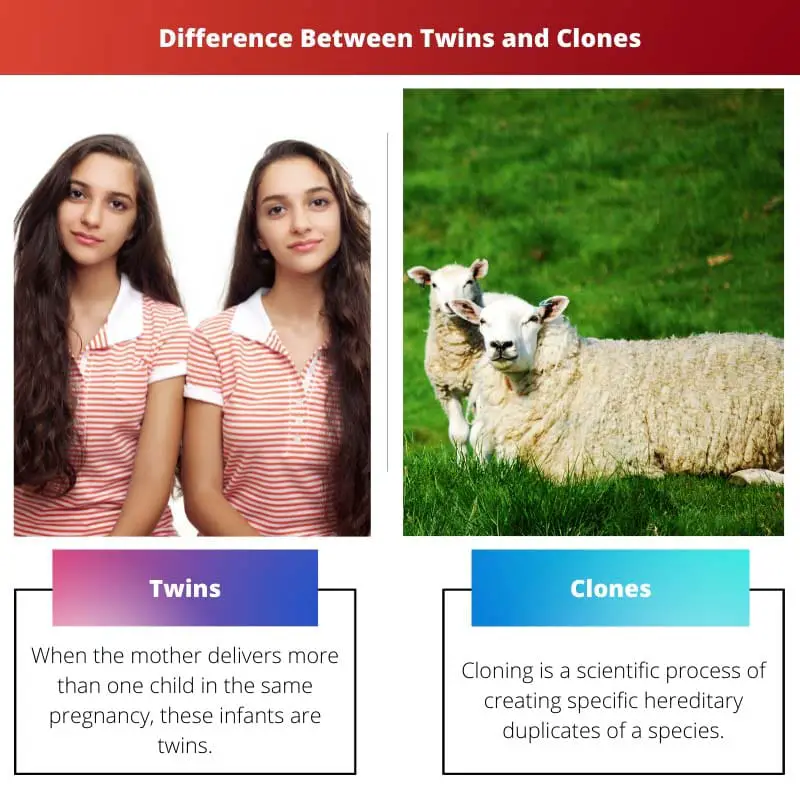Twins and clones resemble their counterparts and are made from the same genes. But both are totally dissimilar from one another. Twins are when a parent delivers newborns at an identical measure. Clones are genetically created through technology.
Key Takeaways
- Twins are siblings born simultaneously, while clones are genetically identical organisms created artificially.
- Twins can have different physical and personality traits, while clones are similar.
- Twins are natural occurrences, while clones are artificial.
Twins vs Clones
Twins are genetically identical individuals who share the same DNA, and are formed when a fertilized egg splits into two identical embryos. Clones, are artificially created by replicating the genetic material of a single donor organism, resulting in a genetically identical copy of the original.

Twins are naturally born together with a minimal time difference between birth times. Twins can be identical, which means they develop from a single zygote that splits into two embryos.
Dizygotic or fraternal develops from a separate egg and is then fertilized by its sperm cell.
Cloning is a process of developing an exact genetic copy of an organism by either doctors or scientists. Cloning either creates DNA pieces (molecular cloning) or species(cell cloning).
It is gaining popularity in creating DNA structures to cure diseases.
Comparison Table
| Parameters of Comparison | Twins | Clones |
|---|---|---|
| Birth | They are delivered consistently at an equal time. | Clones are fabricated on a research basis. |
| Sex | They can likewise be a boy or a girl. | Due to the absence of Y chromosomes, the clone is mostly female. |
| Occurrence | It is a natural occurrence. | It is artificially created. |
| Age | They are of identical age. | The clone is junior to the other. |
| Creation | It occurs due to the splitting of a zygote into two parts. | DNA implementation into an external egg. |
What are Twins?
When the mother delivers more than one child in the same pregnancy, these infants are twins. A fertilized egg (ovum) loops and evolves into two indistinguishable babies with indistinguishable genetic details.
In fraternal twins, two eggs fertilize with two sperm, and two genetically unique children with different looks are born. There are numerous factors responsible for the birth of twins.
- Older Women- The higher level of estrogen in women aged between 30-40 enables them to produce beyond one egg every so often.
- The number of previous pregnancies- The more numeral of pregnancies, the higher leads to the likelihood of conceiving twins.
- Heritage- Women are more likely to have twins if there is a history of twins in their family.
- Race- Black American Women currently rank the highest in the statistics of conceiving twins, and Asians rank the lowest.
- Assisted Reproductive techniques-Fertility, drugs and stimulants release several eggs per ovulation.
The most common type of twins are fraternal and identical, but there are rare subtypes too:
- Identical or monozygotic twins- The most common type of twins. The fertilized eggs divide into two and develop into twins with similar genetic information twin right side of the child matches with the left side of their twin.
- Fraternal or dizygotic twins- In these two separate eggs fertilize with two sperms. These twins look alike. These can be same-sex or different-sex.
- Proposed third twin- There is research to understand this type of twin, but medical opinions are divided over this theory. Once the egg is split into half, the smaller part is the polar body. It contains all the chromosomes, but the fluid cytoplasm is too little to survive. There is a possibility the polar body might survive. The Polar twins share the same chromosome as their mother, and they get different chromosomes from their father as they are created from a single cell but different sperms.
Most twins are either fraternal or identical, a third type of polar body twins might exist. The other subset exists under unusual circumstances.

What are Clones?
Cloning is a scientific process of creating specific hereditary duplicates of a species. Cloning either generates reprints of genes (molecular duplicating) or creatures (cell imitating).
Molecular duplicating is making multiple molecules. It amplifies(larger) DNA fragments.
Cloning takes place in four stages:
- Breaking up the DNA (dissolution)
- Pasting rear the gene in the wanted order (association)
- Placing the overhead order with an altered gene (inactivation)
- Choosing the flow of the successful transfected (screening/selection)
Cloning has successfully been experimented with animals. It requires more than two creatures. The core of an egg gamete from one creature gets detached and returned with the core of the subsequent creature and then embedded into the tertiary creature.
The clone is uniform to the subsequent creature. All these processes occur in a lab or a petri dish. In bodily embryo core shift, bodily embryos get all of the cores that make the entity.
As somatic cells contain two sets of chromosomes, the scientist transfers the gene from the creature’s bodily embryo into the gamete core, where the gene and centre detach.
This egg develops into an embryo with the same genes as the cell donor.
In 1996, a Scottish scientist cloned the first animal named Dolly. It took 276 scientists to get the first clone, Dolly. The cloning of stem cells may provide a cure for many diseases. It may provide organs for transplantation.
Cloning humans is considered unethical, may create an imbalance in our society, and endanger the human race.
Main Differences Between Twins and Clones
- Twins are delivered at a similar rhythm. Scientists or doctors fabricate clones.
- The twins are equivalent generation. The clones are budding than the donor.
- The twins can be male or female. The bodily unit clone does not have a Y genetic code.
- The genetic acid of the mother and father are responsible for twins being born. Clones are created with the help of somatic cells taken from the mother.
- Twins are born as the zygote splits into two. Clone is the result of DNA implantation.




